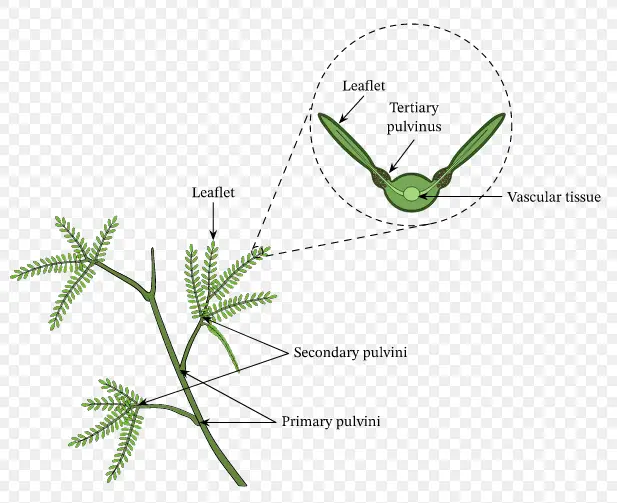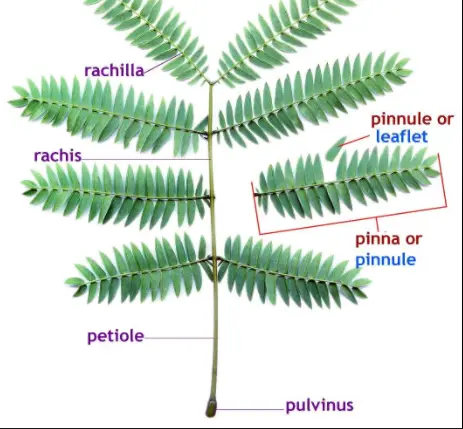Plants are complex organisms that exhibit a range of structural adaptations to thrive in diverse environments. Among these structures, the pulvinus and petiole play critical roles, though their functions and appearances are distinct. By understanding these parts, one gains insight into the intricate ways plants interact with their surroundings.
The pulvinus is a specialized joint at the base of a leaf or leaflet that facilitates movement, while the petiole is the stalk that attaches the leaf blade to the stem, supporting the leaf and connecting it to the vascular system of the plant. This distinction is crucial for recognizing how plants adapt to maximize light capture and minimize damage from environmental factors.
In the realm of botany, the differences between the pulvinus and petiole are not merely anatomical curiosities but are vital for the plant’s ability to adapt and survive. Each structure has developed to serve specific functions that impact the plant’s growth, nutrient intake, and resilience against external stresses.

Pulvinus Defined
Location and Structure
The pulvinus is an intriguing plant structure located at the base of a leaf or leaflet, primarily in members of the legume family and a few other plant groups. It appears as a small, cushion-like swelling that plays a pivotal role in leaf positioning and movement. The cellular composition of the pulvinus allows it to change shape and rigidity in response to environmental stimuli. This structure is comprised of motor cells that can rapidly alter their turgor pressure, which is the force within the cell that pushes the plasma membrane against the cell wall.
Functionality in Plants
Functionally, the pulvinus enables leaf movements such as nyctinasty (night closure) and photonasty (movement in response to light), which are essential for optimizing light capture during the day and minimizing water loss during the night. For instance, in response to the onset of darkness, the pulvinus cells on one side of the leaf base may lose turgor pressure, causing the leaf to fold or droop, a mechanism that can also reduce the risk of damage from cold or predation.
Petiole Explained
Anatomical Features
The petiole is the stalk that connects a leaf blade to the plant stem, offering a critical support structure that allows the leaf blade to maximize sunlight absorption. Anatomically, petioles vary greatly among plant species in terms of length, thickness, and flexibility. They contain vascular tissues, which are essential for the transport of water and nutrients from the stem to the leaves and vice versa. This connection helps distribute the products of photosynthesis to other parts of the plant.
Roles in Plant Physiology
In plant physiology, the petiole’s role extends beyond mere physical support. It influences the leaf’s exposure to light and air, significantly impacting photosynthesis and transpiration rates. The ability of the petiole to angle the leaf properly can determine the efficiency with which a plant captures sunlight and exchanges gases with the environment, crucial for its growth and survival.
Comparing Structures
Physical Differences
While both the pulvinus and petiole are involved in supporting the leaf, their physical characteristics and functions differ markedly. The pulvinus is generally shorter and capable of swelling and shrinking, which directly facilitates movement. In contrast, the petiole is usually longer, primarily serving as a sturdy support that positions the leaf in an optimal orientation for light absorption and gas exchange.
Attachment and Position
The attachment and position of the pulvinus and petiole also highlight their distinct roles. The pulvinus is located at the very base of the leaf or leaflet, acting as a joint that provides the necessary movements for adaptive responses. On the other hand, the petiole extends from the stem to the leaf blade, functioning as a crucial conduit for the resources necessary for photosynthesis and growth.
Functional Contrast
Movement and Flexibility
The pulvinus and petiole exhibit distinct functional differences, particularly in their ability to facilitate movement and flexibility. The pulvinus enables dynamic movements in the leaf, such as the opening and closing in response to diurnal light changes. This flexibility is due to changes in turgor pressure within its cells, allowing plants like the Mimosa pudica (sensitive plant) to rapidly fold its leaves in response to touch or shock.
In contrast, the petiole, while not involved in such rapid movements, provides mechanical flexibility that helps leaves sway without breaking under the forces of wind. This type of flexibility is crucial for reducing physical stress and damage to the leaf and stem structure, thereby enhancing the plant’s ability to thrive in varying environmental conditions.
Water and Nutrient Transport
The role of the petiole extends into the essential function of water and nutrient transport. It houses vascular bundles consisting of xylem and phloem. The xylem transports water and soluble mineral nutrients from the roots to the leaves, while the phloem distributes the sugars and products of photosynthesis from the leaves to other parts of the plant. This transportation system is vital for the plant’s nutrition and overall health.
Ecological Significance
Adaptation and Survival
The ecological significance of the pulvinus and petiole is evident in their contribution to plant adaptation and survival. The pulvinus, for example, allows leaves to adjust their position throughout the day, maximizing light capture and minimizing water loss, which is particularly beneficial in arid environments. This adaptability enhances the plant’s ability to survive under diverse and changing climatic conditions.
The petiole supports survival by maintaining the leaf in an optimal position for photosynthesis and transpiration, ensuring the plant can efficiently produce energy and manage water use. This adaptability is crucial for survival in ecosystems where light and water availability may vary dramatically.
Role in Plant Growth
Both structures play significant roles in plant growth. By optimizing leaf position for effective light absorption and helping regulate water loss during critical times, they directly influence the plant’s growth rate and health. Efficient photosynthesis enabled by proper leaf positioning leads to more robust plant growth and higher reproductive success.
Case Studies
Examples in Different Species
Several case studies highlight the varied roles of the pulvinus and petiole across different species. For instance, in the sensitive plant (Mimosa pudica), the rapid folding of leaves due to the pulvinus’s response to touch serves as a defense mechanism against herbivores. In contrast, the sunflower uses its petioles to orient its leaves throughout the day to follow the sun, maximizing photosynthesis.
Research Findings
Recent research has provided insights into the molecular mechanisms behind the movements facilitated by the pulvinus and the strength provided by the petiole. Studies have identified specific proteins and ions involved in the turgor pressure changes in the pulvinus, which are critical for its movement. Meanwhile, research on the petiole has explored how its structural integrity is maintained even under significant physical stress, ensuring that the leaf remains optimally positioned for essential functions like photosynthesis.
FAQs
What is a pulvinus?
The pulvinus is a flexible joint at the base of a plant’s leaf or leaflet that helps in movement. This movement can be a response to environmental stimuli, such as light and gravity, allowing the plant to optimize its exposure to necessary resources.
How does a petiole function?
A petiole functions as the connecting bridge between a leaf and its stem, supporting the leaf blade and facilitating the transport of nutrients and water. It plays a critical role in the photosynthesis process by maintaining the leaf in the best position to receive sunlight.
Are pulvinus and petiole found in all plants?
No, the presence of a pulvinus and a petiole varies among plant species. While most flowering plants have petioles, the pulvinus is typically found in certain families, such as Fabaceae, enabling leaf movement in response to environmental changes.
How do pulvinus and petiole contribute to plant adaptation?
The pulvinus and petiole contribute significantly to plant adaptation by enhancing their ability to adjust to varying light conditions and supporting structural stability and nutrient distribution, respectively. These adaptations are crucial for survival in diverse environments.
Conclusion
In exploring the distinctions between the pulvinus and petiole, we uncover layers of complexity within plant physiology that underscore the evolutionary adaptations of plants. These structures are not merely parts of a plant but are dynamic elements that enhance survival and efficiency in response to environmental challenges.
As we appreciate these nuances, the study of pulvinus and petiole not only enriches our understanding of botany but also highlights the sophisticated mechanisms plants have evolved to navigate their ecosystems. This knowledge is essential for anyone interested in the biological sciences, offering insights into the resilience and adaptability of the natural world.

